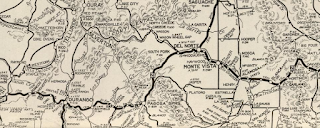Upon reaching Durango via US Route 550 over the San Juan Mountains I picked up US Route 160. After following a multiplex of US 160/US 550 south of Durango I cut east on the former towards Wolf Creek Pass.
This article serves as the 23rd entry in the 2016 Summer Mountain Trip series. Part 22 covered US Route 550 from Montrose south to Durango over the Million Dollar Highway.
2016 Summer Mountain Trip Part 22; US Route 550, the Million Dollar Highway, and San Juan Skyway
Wolf Creek Pass lies at an elevation of 10,857 feet above sea level within the San Juan Mountains of Mineral County. Wolf Creek Pass serves as part of the Continental Divide between the Pacific Ocean and Atlantic Ocean. Flanked by the watershed of Wolf Creek to the west and the South Fork Rio Grande River to the east Wolf Creek Pass might not be among the most infamous of the mountain passes in Colorado...but it still is famous.
The history of Wolf Creek Pass is surprisingly modern as it opened during August of 1916 as part of the Spanish Trail and Grand Canyon Highway. During the rise of the automobile in the early 20th Century a direct route through Southern Colorado was highly desired. The route over Wolf Creek Pass was funded by; the Del Norte Commercial Club, the town of Del Norte, the town of Pagosa Springs, Rio Grande County, Archuleta County, the State of Colorado, the U.S. Forest Service, and even the Federal Government (holy crap, why can't we give this level of involvement anymore with road projects?). The History & Heritage Page for the Town of South Fork has more history on crossings of the San Juan Mountains. The History & Heritage Page also hosts this photo of the opening celebration of Wolf Creek Pass opening in August 1916.
Wolf Creek Pass can be seen on the 1924 Rand McNally Regional Map as part of the Spanish Trail and National Park-to-Park Highway.
When the US Route System was created in late 1926 US Route 450 was plotted over Wolf Creek Pass. US 450 along with Colorado State Route 10 be seen plotted over Wolf Creek Pass on the 1927 Rand McNally Highway Map of Colorado.
According to USends US Route 160 replaced much of US 450 west to the Utah State Line in 1934 and subsequently was routed over Wolf Creek Pass. US 160 can be seen routed over Wolf Creek Pass on the 1939 Rand McNally Highway Map of Colorado.
US 160 has remained the highway over routed Wolf Creek Pass since 1934. Wolf Creek Pass entered the lexicon of popular culture by way of C.W. McCall's 1975 Album and 1974 Song both titled "Wolf Creek Pass." The lyrics of Wolf Creek Pass are as follows:
This article serves as the 23rd entry in the 2016 Summer Mountain Trip series. Part 22 covered US Route 550 from Montrose south to Durango over the Million Dollar Highway.
2016 Summer Mountain Trip Part 22; US Route 550, the Million Dollar Highway, and San Juan Skyway
Wolf Creek Pass lies at an elevation of 10,857 feet above sea level within the San Juan Mountains of Mineral County. Wolf Creek Pass serves as part of the Continental Divide between the Pacific Ocean and Atlantic Ocean. Flanked by the watershed of Wolf Creek to the west and the South Fork Rio Grande River to the east Wolf Creek Pass might not be among the most infamous of the mountain passes in Colorado...but it still is famous.
The history of Wolf Creek Pass is surprisingly modern as it opened during August of 1916 as part of the Spanish Trail and Grand Canyon Highway. During the rise of the automobile in the early 20th Century a direct route through Southern Colorado was highly desired. The route over Wolf Creek Pass was funded by; the Del Norte Commercial Club, the town of Del Norte, the town of Pagosa Springs, Rio Grande County, Archuleta County, the State of Colorado, the U.S. Forest Service, and even the Federal Government (holy crap, why can't we give this level of involvement anymore with road projects?). The History & Heritage Page for the Town of South Fork has more history on crossings of the San Juan Mountains. The History & Heritage Page also hosts this photo of the opening celebration of Wolf Creek Pass opening in August 1916.
Wolf Creek Pass can be seen on the 1924 Rand McNally Regional Map as part of the Spanish Trail and National Park-to-Park Highway.
When the US Route System was created in late 1926 US Route 450 was plotted over Wolf Creek Pass. US 450 along with Colorado State Route 10 be seen plotted over Wolf Creek Pass on the 1927 Rand McNally Highway Map of Colorado.
According to USends US Route 160 replaced much of US 450 west to the Utah State Line in 1934 and subsequently was routed over Wolf Creek Pass. US 160 can be seen routed over Wolf Creek Pass on the 1939 Rand McNally Highway Map of Colorado.
US 160 has remained the highway over routed Wolf Creek Pass since 1934. Wolf Creek Pass entered the lexicon of popular culture by way of C.W. McCall's 1975 Album and 1974 Song both titled "Wolf Creek Pass." The lyrics of Wolf Creek Pass are as follows:







Comments
Mike Macey
http://ColoradoMuseums.CO